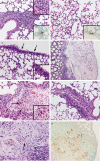Dendritic cells overexpressing Fas-ligand induce pulmonary vasculitis in mice
- PMID: 15196246
- PMCID: PMC1809076
- DOI: 10.1111/j.1365-2249.2004.02514.x
Dendritic cells overexpressing Fas-ligand induce pulmonary vasculitis in mice
Abstract
Dendritic cells (DC) genetically engineered to express Fas (CD95) ligand (FasL-DC) have been proposed as immunotherapeutic tools to induce tolerance to allografts. However, we and others recently showed that FasL-DC elicit a vigorous inflammatory response involving granulocytes and can promote Th1-type CD4+ and cytotoxic CD8+ T lymphocytes. This prompted us to evaluate the pathology induced by intravenous injection of FasL-DC in mice. We observed that FasL-DC obtained after retroviral gene transfer of bone marrow precursors derived from Fas-deficient C57Bl/6 mice induce massive pulmonary inflammation and pleuritis one day after a single intravenous injection in C57Bl/6 mice. Two months later, all mice presented granulomatous vasculitis of small to medium sized vessels, alveolar haemorrhage and pleuritis. In these lesions, apoptotic bodies were found in large number. Anti-neutrophilic cytoplasmic and anti-myeloperoxidase autoantibodies were not detected. This study documents that intravenous injection of FasL-DC causes severe lung granulomatous vasculitis. This new animal model for vasculitis is inducible, highly reproducible and shares many features with human Wegener granulomatosis. This model may be an appropriate tool to further investigate the pathogenesis of vasculitis and test new therapeutic strategies. Moreover, our findings highlight the potential severe complications of FasL-DC-based immunotherapy.
Figures

Similar articles
-
Exosomes derived from genetically modified DC expressing FasL are anti-inflammatory and immunosuppressive.Mol Ther. 2006 Feb;13(2):289-300. doi: 10.1016/j.ymthe.2005.09.015. Epub 2005 Nov 7. Mol Ther. 2006. PMID: 16275099
-
Antineutrophil cytoplasmic autoantibody-associated alveolar capillaritis in patients presenting with pulmonary hemorrhage.Arch Pathol Lab Med. 1994 May;118(5):517-22. Arch Pathol Lab Med. 1994. PMID: 7910729
-
Ultraviolet light-induced immune tolerance is mediated via the Fas/Fas-ligand system.J Immunol. 1998 May 1;160(9):4262-70. J Immunol. 1998. PMID: 9574528
-
Dendritic cells transduced with viral interleukin 10 or Fas ligand: no evidence for induction of allotolerance in vivo.Transplantation. 2002 Jan 15;73(1 Suppl):S27-30. doi: 10.1097/00007890-200201151-00010. Transplantation. 2002. PMID: 11810058 Review.
-
Inhibition of Fas/Fas ligand-mediated apoptotic cell death of lymphocytes in vitro by circulating anti-Fas ligand autoantibodies in patients with systemic lupus erythematosus.Arthritis Rheum. 1998 Feb;41(2):344-53. doi: 10.1002/1529-0131(199802)41:2<344::AID-ART19>3.0.CO;2-J. Arthritis Rheum. 1998. PMID: 9485093 Review.
Cited by
-
Killer artificial antigen-presenting cells: a novel strategy to delete specific T cells.Blood. 2008 Apr 1;111(7):3546-52. doi: 10.1182/blood-2007-09-113522. Epub 2007 Dec 20. Blood. 2008. PMID: 18096763 Free PMC article.
-
Dendritic cell-based approaches for therapeutic immune regulation in solid-organ transplantation.J Transplant. 2013;2013:761429. doi: 10.1155/2013/761429. Epub 2013 Oct 24. J Transplant. 2013. PMID: 24307940 Free PMC article. Review.
-
Animal models of vasculitides.Clin Rev Allergy Immunol. 2008 Oct;35(1-2):11-8. doi: 10.1007/s12016-007-8063-9. Clin Rev Allergy Immunol. 2008. PMID: 18188707
-
Incomplete Killing And Enhanced Activation of Islet-Reactive CD8+ T Cells by FasL-Expressing Dendritic Cells Limits Protection from Diabetes.Rev Diabet Stud. 2008 Fall;5(3):144-53. doi: 10.1900/RDS.2008.5.144. Epub 2008 Nov 10. Rev Diabet Stud. 2008. PMID: 19099086 Free PMC article.
-
An Antigen-Presenting and Apoptosis-Inducing Polymer Microparticle Prolongs Alloskin Graft Survival by Selectively and Markedly Depleting Alloreactive CD8+ T Cells.Front Immunol. 2017 Jun 9;8:657. doi: 10.3389/fimmu.2017.00657. eCollection 2017. Front Immunol. 2017. PMID: 28649247 Free PMC article.
References
-
- Krammer PH. CD95′s deadly mission in the immune system. Nature. 2000;407:789–95. - PubMed
-
- Ogasawara J, Watanabe-Fukunaga R, Adachi M, et al. Lethal effect of the anti-Fas antibody in mice. Nature. 1993;364:806–9. - PubMed
-
- Kondo T, Suda T, Fukuyama H, Adachi M, Nagata S. Essential roles of the Fas ligand in the development of hepatitis. Nat Med. 1997;3:409–13. - PubMed
-
- Via CS, Nguyen P, Shustov A, Drappa J, Elkon KB. A major role for the Fas pathway in acute graft-versus-host disease. J Immunol. 1996;157:5387–93. - PubMed
MeSH terms
Substances
LinkOut - more resources
Full Text Sources
Medical
Research Materials
Miscellaneous

